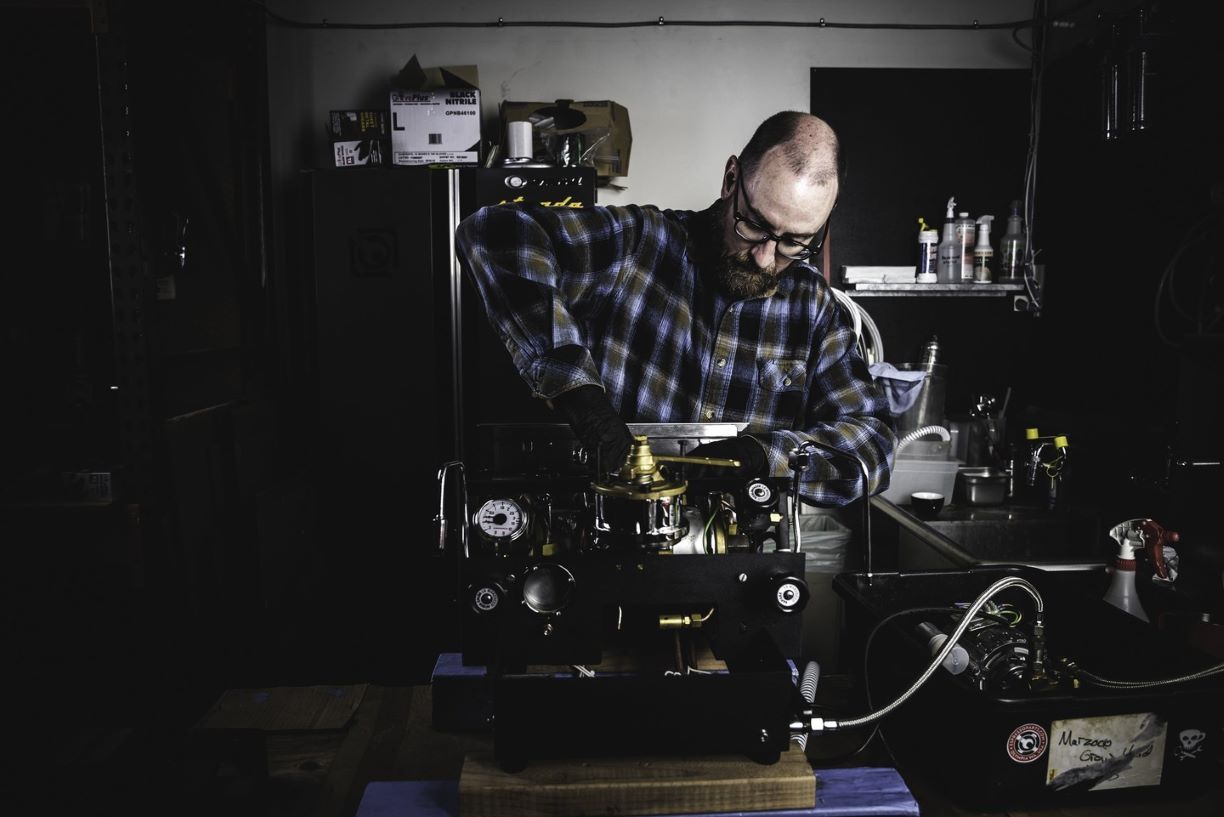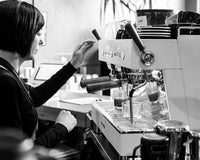Opening a café is exciting, but there’s a lot to balance. Whether you’re in the daydreaming stage or you’re ready to purchase your coffee equipment right now, knowing what to prioritize at each stage can make your journey smoother and make sure you’re fully prepared on opening day.
At Espresso Parts, we love helping people at any and every step of setting up a café. To help mitigate some of the stress of starting a new business, we’ve made a timeline-based guide with what you should be thinking about from early planning to opening your doors. Our team is here so you can build your coffee shop business plan with confidence.
Use this guide to get organized, set goals, and know when to start shopping for essentials like your commercial espresso coffee machine.
Still Dreaming? Start Your Coffee Shop Business Plan
If you’re in the dreaming phase — maybe you’re saving, researching, waiting for the right time, or just daydreaming of a better career — you can still lay important groundwork today.
Decide the vibe of your dream café
Think about the atmosphere you want to create. Cozy neighborhood spot? Modern minimalist? Do you want customers to order a drink and hang out, or would you prefer to keep your spot mostly to go? Comfortable seating will encourage people to enjoy their coffee in the shop, while using only stools will make it more of a stop than a destination.

Identify your ideal café customer
Are you serving commuters, remote workers, or weekend brunch crowds? Are you anticipating customers who want the best single origins and funky new processing methods, or are you looking to serve more approachable coffee that everyone in town can afford?
Scout general future café locations
Even if you’re not signing a lease soon, it's never too soon to start researching areas with good foot traffic and compatible businesses nearby. The location can make or break a business.

More dreamer to-dos
Talk to other café owners, visit local coffee shops, and take notes on what you love and what’s missing from the coffee community in your town.
This is the time to dream big, brainstorm wild ideas, and start outlining your coffee shop business plan.
1–2 Years Out: Plan Your Café Layout and Equipment
If you’re committed to opening a café but aren’t rushing, you should start by creating a detailed plan and setting a strong foundation.
At this point, you should have a pretty good idea of where you want your coffee shop located. Now it’s time to get specific. What size and layout will suit your vision?
Begin the process of making a floor plan
Begin outlining your general floor plan. Consider customer flow, service counters, seating, retail areas, and back-of-house needs. You should have your dream solidified at this point, and now you can start thinking about the steps you need to take to bring that vision to life.

Start thinking about equipment
Start researching your equipment needs early. It’s helpful to get familiar with options for espresso machines, grinders, brewers, and water filtration systems for your coffee shop. Make a list of everything you’ll need and decide how much you want to spend overall. While it’s tempting to choose the most expensive, well-known espresso machine, remember that many more affordable models are well-built and feature-rich.
Starting early helps you spread out costs and avoid last-minute stress. Reach out to our sales team to help you navigate the process.
Need more inspiration? Check out our Top Espresso Machines and Top Commercial Grinders
6–12 Months Out: Finalize Equipment and Utilities
You’re getting closer — this is the ideal window to start working out specific details.
General layout planning
Finalize your floor plan with a focus on the practical requirements for your equipment. Ensure you have detailed plans for electrical outlets, dedicated circuits, plumbing lines, drainage, and ventilation. Work closely with an expert in this field to make sure all utility connections meet code and have enough power for your future equipment’s specifications.

Decide essential equipment
Create a comprehensive equipment list tailored to your menu and service style. Think beyond the basics of commercial espresso machines and commercial grinders. Consider batch brewers, manual or automated pour-over bars, water filtration systems, undercounter refrigerators, milk pitcher rinsers, prep sinks, and anything else you’re going to need. Factor in capacity needs, workflow, and future growth — and make sure this equipment aligns with your floor plan.
Research local regulations
Familiarize yourself with all relevant local health department codes, ADA accessibility standards, and building or business permit requirements.
Water filtration planning
Do not skip this step. It’s critical for protecting your gear and delivering great coffee. It may be a bit more work upfront, but this will absolutely be worth it. Hard water ruins equipment, and we want your investment to last.
Still need help? Check out our Equipping Your Café guide
3–6 Months Out: Menu, Financing, and Volume
You’re in the crucial planning phase before opening — time to get specific.
Draft your menu
You don’t have to finalize this yet, but start thinking about the roaster or roasters you’ll use. Will you just be serving coffee, or will you offer other drinks, like tea and matcha? Will you have pastries, and if you do, will they be baked in-house or ordered from a local bakery?
Choose your equipment and figure out financing
Once you figure out your menu, decide what you need to execute it. Drip coffee? Espresso drinks? Pour-overs? Choose equipment that matches your menu and volume expectations. This is also a great time to start deciding how you’re going to finance your purchases.
Invest wisely. Look for quality you can grow into — reliable, well-cared-for equipment will save money over time and decrease the chance of unexpected breakdowns.
And, if you’re going all in on your brand vision, you may want to look into customizing your equipment. Looking for more information on our custom equipment options? Check out our request form and see examples of our custom shop's work.

Plan your payment setup
Choose a point-of-sale (POS) system that supports your business model, whether that includes in-person or mobile orders. Evaluate payment processors for competitive rates, ease of use, and integration with any other tech you’ll be using. Don’t forget to develop a clear pricing strategy that balances profitability with market expectations while supporting smooth transactions at the counter.
Estimate volume
Determine your expected sales volume. Consider peak hours, seasonal trends, and seating capacity to anticipate customer flow. And keep in mind, it’s typically good to choose equipment that will grow with you so you’re not back here looking for a new espresso machine in a year or two.
0–2 Months: Install, Train, and Market
You’re almost there! It’s time for final touches and preparation to open.
Get your café equipment ready
Order your equipment early enough that you have lead time for delivery, installation, and barista training. We have installation guides to help you with this process — we know this is crunch time and want to make it as straightforward as possible.

Complete the menu
Finalize recipes, calibrate your equipment, taste-test everything. When picking ingredients (milk, milk alternatives, sugar, etc.) choose options that align with your goals and make sure you don’t forget the cost of these when you’re pricing your menu.
You’ll also need to figure out syrups. Will you make or buy syrups? Either way, try a variety until you find your favorite.
A few more things to consider
Will you have retail options? Consider selling retail beans, mugs, or branded merchandise. And look into retailer discounts, like our Wholesale Program.
Basic marketing
Some people love it, some people hate it, but either way you’re going to have to invest time (and probably money) in marketing. Start with easy steps like creating your social media profiles, crafting a Google Business listing, and making a website.

Preparing your baristas
Staff training is crucial. Make sure your baristas are comfortable with the equipment, recipes, and customer service.
No matter where you are in the journey of starting a coffee shop, planning ahead pays off. From choosing equipment to planning installation and training, we’re here to help you at every stage.
Ready to take the next step? Check out our Coffee Bar Equipment checklist for even more details.
FAQs
Q: How do I start planning my coffee shop?
A: Start with getting a clear vision of your dream space and your customer. Sketch out your business plan, research equipment options, and scout locations early. The more you plan now, the smoother your build-out and opening day will be.
Q: What’s the best timeline for opening a café?
A: It depends on your goals and budget, but most cafés plan 12–24 months out. Our guide breaks it down step by step so you know what to focus on at every stage.
Q: What equipment do I need for a coffee shop?
A: You'll need the essentials: a commercial espresso machine, two or three grinders, brewers, water filtration, refrigeration, and prep sinks. Your list should match your menu and workflow.
Q: How early should I order café equipment?
A: Aim for 2–6 months before opening. That gives you time for delivery, installation, barista training, and any last-minute adjustments—so you're dialed in and ready to serve on day one.
Q: How much does it cost to open a coffee shop?
A: It really varies depending on your location, size, and concept. Think through rent, renovations, equipment, staff, permits, and inventory. Planning ahead helps you budget smart and avoid surprises.






